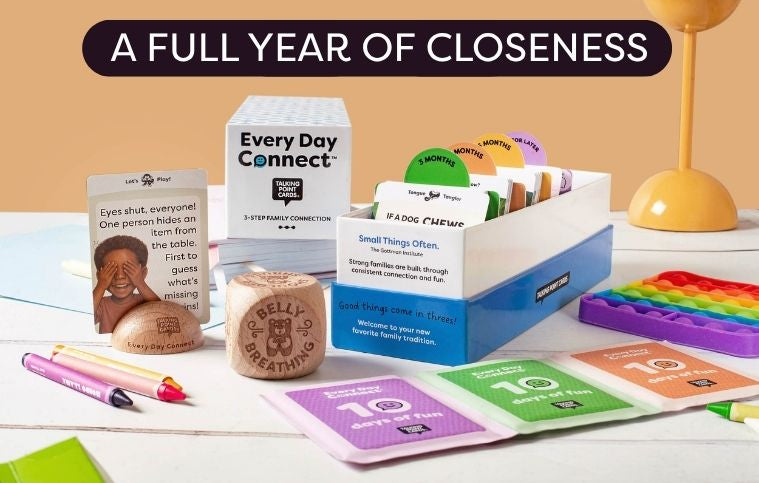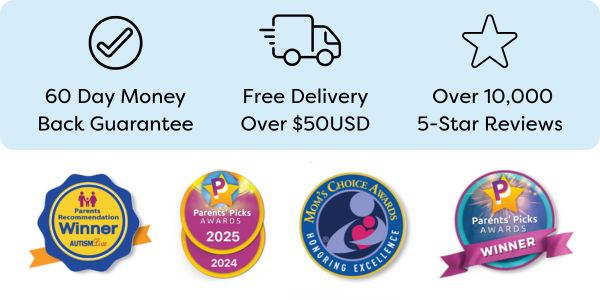SHOP
About
Teen Conversations in the Digital Age
Finding Common Ground

You know that feeling when you're trying to talk to your teenage kid and it feels like you're on opposite sides of an uncrossable chasm?
Yeah, me too.
Teenage years are the Candyland of emotional roller coasters, hormonal hurricanes, and the battling dualities of desperately wanting independence while still needing support and guidance. As parents, we find ourselves struggling to meaningfully connect with these small humans-turning-adults whose brains are going through...well...basically a entire home renovation project.
And just to add an extra dollop of chaos to the mix, teens today are navigating the complexities of the digital age in a way previous generations could never fathom. Between social media, instant messaging, and an endless barrage of content and stimulation, having meaningful conversations with teens can feel like...I don't know...like trying to teach a goldfish to SCUBA dive.
But before you throw in the towel and resign yourself to a lifetime of one-word-answer conversations, let's take a step back. Because despite the unique challenges of the digital era, having meaningful discussions with teens is still very much possible. It just requires some creative reframing and intentional effort on our part.
Why Meaningful Conversations Matter (Like, a Lot)

In the busy hustle of modern family life, it's easy to let actual conversations fall by the wayside. We shout logistics at each other as we're running out the door - "Don't forget your cleats!" "Your piano lesson got rescheduled!" We share surface-level updates over a rushed family dinner between everyone's activities.
But moving beyond that transactional communication and into something deeper? Well, as one of my favorite authors Brené Brown says, that's where the magic happens. That's where real connection forms, where trust strengthens, where we learn how to see each other.
Meaningful conversations with teens provide a vital channel of communication during a period of intense growth and change. Through these talks, we can:
-
Help shape their moral compass and pass on key values
-
Allow them to process complex emotions in a supportive environment
-
Encourage independent thinking and learn from _their_ perspectives
-
Nurture self-awareness, confidence and a strong sense of identity
-
Strengthen family bonds through vulnerability and mutual understanding
In short, engaging discussions shape teens in profound ways. They help lay the foundation for healthy adulthood and lasting parent-child relationships.
Sure, on a surface level all conversations may FEEL frivolous or tedious in the moment. But viewed through a wider lens, they're anything but trivial. Like tiny lego bricks, stacked conversation by conversation, they're building the pathway that will carry your child into their future.

Welcome to the Digital Battleground of Communication
Let's face it: the digital world adolescents inhabit today is a whole new beast. One that has completely transformed the teenage conversational landscape. And one we, as parents, often find bewildering to navigate.
Some of the biggest disruptors to traditional teenage communication include:
Social Media & Fear of Missing Out (FOMO)
For today's teens, a large chunk of their social lives play out through curated online personas and endless content streams. It's a delicate dance of sharing just the right selfie (but not trying too hard) and keeping up with the latest trends, memes, and drama amongst their circle.
FOMO - the fear of missing out - is a very real source of anxiety. Because in the digital realm, there's always something happening without you and endless opportunities to feel excluded.
Instant Messaging, Shortened Attention Spans and Communication "Snacking"
With apps like Snapchat, Instagram DMs, and good old fashioned texting, today's teens are accustomed to constant brief bursts of communication throughout the day—vivid videos and images swapped at lightning speed with captions and comments.
In many ways, it's made communication easier. There's less anxiety around initiating a conversation ("Hey, you up?" or sending a silly selfie is a much lower bar to clear). At the same time, with everything moving so fast, it's also wired teens for shorter attention spans and constant distraction.
The Fractured Realities of Online and IRL Communication
One of the biggest challenges of the digital age is the jarring disconnect between a teen's online persona and their in-real-life (IRL) identity. What they share on social media is a highlight reel - often curated to portray a specific image. The things they say to peers over private text are different still from how they actually behave in person.
This fractured sense of persona can understandably breed authentic communication issues. Where's the "real" version of them supposed to exist? And as parents trying to connect, which version are we even talking to?
Privacy Concerns & Building Trust
Teens are notorious for guarding their privacy (especially from prying parental eyes). In the digital age, those instincts are only amplified. It's easier than ever for teens to hide or distort aspects of their lives through private messaging, coded language, finsta (fake Instagram) accounts, and more.
But while privacy is understandable, it also erects walls that can prevent meaningful conversations from happening. After all, how can you really connect with someone when they won't let you through the gate?
The Ongoing Battle for Attention
Finally, of course, there's the universal struggle of the digital age: _capturing_ and maintaining anyone's attention for more than a few fleeting seconds. The constant deluge of entertainment, information, and dopamine-hitting stimuli has reframed human attention span into a rare and precious commodity.
This means when you actually DO find yourself with your teen's eyeballs on you during a conversation, you're up against some fierce competition in the form of buzzes, beeps and pings from every device around them. One poorly-timed notification could cost you any
chance of truly connecting.
So in light of these disruptive forces, how exactly are we supposed to have meaningful conversations with our teens? How can we possibly hope to build connection and nurture strong relationships when the digital landscape is siloing us into separate continents?
The Quest for Meaningful Dialogue: Strategies for Success

I'll be honest—the digital age has _definitely_ made it harder to nurture deep connections with our teens. But you know what? I don't think it's made it impossible. The trick is all in HOW we approach it and go about creating spaces for conversation.
As your industrious scout who's already out there exploring this new frontier, let me offer some wisdom from the trenches. Here are some key strategies for fostering richer discussions with teens:
Understand and validate their digital world
Look, we're never going to fully understand the culture of teenage life online, like actually *grok* its nuances and complexities. Our parental brains are too old and slow and we're already over the hill (even if that hill is barely a hillock). Some of it is just going to remain forever cringe.
BUT, if we make a real effort to learn about the digital ecosystems our teens inhabit—from Twitch and Discord servers to Youtube celebs and TikTok trends—it'll make us way better equipped to meet them where they are. It shows we value their world, even if it sometimes seems zany to us. Validate their digital existence as _real_. Make it clear you respect the ways they authentically connect online, just as you would their in-person relationships. Taking an interest and fostering understanding goes a long, long way.
Use digital channels to open conversational doors
You know how you sometimes have your most intimate talks in the car, or when you're doing dishes together? No pressure, no face-to-face intensity, just a lowered inhibition that allows deeper topics to flow? The digital equivalents are things like text messaging, co-watching a funny show over video chat, or even just hanging out together in a video game lobby. Rather than fight against digital mediums, embrace them as gateways for more meaningful conversations. Let their guard down first by _meeting them_ in their comfortable digital spaces. As the conversation picks up steam, you can then pivot to more direct IRL discussions.
Find settings for device-free downtime
Of course, all this said, face-to-face interactions are still vital for real bonding. The trick is identifying novel settings where digital detox naturally happens. A few winners:
-
Walking the dog together
-
Playing sports/physical activities
-
Doing hands-on projects like cooking, gardening, home improvement
-
Going on drives/road trips (excellent for tapping into that intimate car confessional magic)
-
Camping, hiking or just spending time in nature
A few guidelines to create optimal device-free zones:
-
Make it a predictable routine so it becomes an expected norm ("Phones get parked during our Saturday morning pancake breakfasts")
-
Keep hands and bodies occupied to avoid the "quick peek" reflex
-
Make sure the activity itself is legitimately engaging rather than forced family bonding time
-
Remove temptations by charging phones in another room
The goal is to create sacred pockets where digital life just naturally falls away - allowing for richer presence and connection.
Get ComfortabIe With Silence and Releasing Control
One of the biggest conversation killers? Forcing it. Parents who plow forward peppering question after question, looking for Just. The. Right. Prompt to spark engagement. Teens these days can smell conversational desperation from a mile away— - they'll mentally check out so fast. Instead, resist the urge to constantly reanimate the chat and get comfortable with silence. Let pauses linger. Have the patience to let a teenage mind wander, process and circle back around in its own time. Don't script so tightly that the conversation feels forced or fake.
I'm talking about releasing control and letting the natural rhythm of a real discussion emerge. This can ironically lead to much richer openness and vulnerability than if you try to meticulously guide and dictate every turn. It's about holding an open, non-judgmental space for them to feel safe showing up authentically. Let conversations flow and evolve organically - changing course as needed and going down interesting side trails without an agenda. Provided you've set the right tone, teens are far more likely to lean into meaningful dialogue that way.
Use prompted questions and conversational roadmaps
Have you ever sat down with someone intending to "really talk" only to stare blankly at each other and think "....so, what do we actually talk about?" Cue awkward silence.
Yeah, me too.
This is where having a few prompted questions or conversational roadmaps up your sleeve can be super clutch. Not only do they provide initial momentum to get discussion flowing, but framing topics around questions ultimately leads to much deeper exploration.
Try our teens pack of 200 promts to always keep the conversation flowing.

Nurturing Intergenerational Connections in a Divided World
I'm not gonna lie: our ever-more-digitized society poses profound challenges for deep communication between adults and teens. The social chasms created by technology can feel impossible to bridge at times.
The generation gaps feel VAST. Our cultural contexts are miles apart. And our modes of connecting are continuously shape-shifting and evolving - with the younger generation always seeming to outpace us by insurmountable strides.
But despite all this change and fragmentation, one core human need remains constant: We all want to feel seen. We all want to connect.
No amount of digital distancing or fractured realities can stamp out our primal drive for belonging and shared understanding. The conversational ground between parents and teens may look radically different in the modern age.
But the quest to find common ground? That mission remains as relevant as ever.
So let's keep exploring. Let's get curious about each other's worlds instead of shutting them down or ignorantly dismissing. Let's embrace new mediums for dialog while also carving out sacred spaces to unplug. And most importantly, let's listen - setting aside our agendas to
create room for raw honesty.
With consistent commitment, open-mindedness and an embrace of novel approaches, we absolutely can build rich connections that transcend all the diversions and divisions of the digital age.
After all, no matter how rapidly our means of communicating evolve, the human need to share stories, lessons and lived experiences with one another? That part is forever timeless.
LIKED THIS ARTICLE?
SIGN UP FOR MORE!






